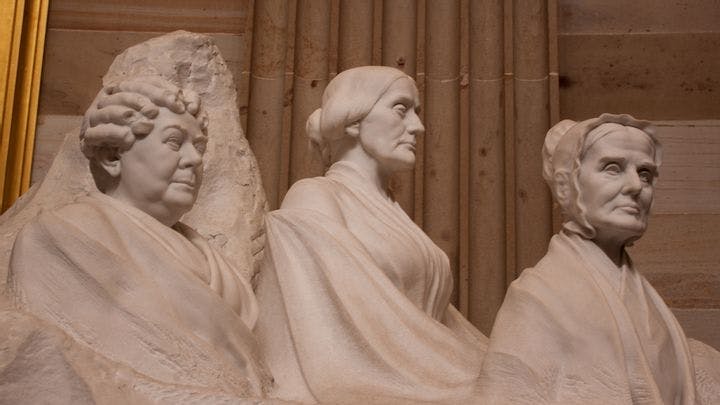Summer 2011
Free-for-all
– Nina Silber
For a moment amid the ferment after the Civil War, it seemed possible to at least some Americans that women would win the right to vote.
For a moment amid the ferment after the Civil War, it seemed possible to at least some Americans that women would win the right to vote. The abolition of slavery put broad questions of voting rights and citizenship on the table, and legislators were eager to act. Women suffragists hoped their time had come. Instead, they saw their “fighting chance” evaporate with the ratification in 1870 of the Fifteenth Amendment, which outlawed disenfranchisement on the basis of race but not of sex. Women would have to wait half a century before they secured the vote in 1920.
Faye E. Dudden, a professor of history at Colgate College, attempts to shed new light on this episode in Fighting Chance. Hers is a tale of the ideological, political, and often intensely personal disputes that pitted former political allies in the abolitionist cause—including Wendell Phillips, Lucy Stone, Frederick Douglass, Elizabeth Cady Stanton, and Susan B. Anthony—against one another. As they organized and campaigned for suffrage reforms around the country, these ardent activists eventually divided over the Fifteenth Amendment, which Stanton and Anthony did not support because it failed to give women the vote.
Indeed, the two women ended up espousing a racist agenda that denigrated African-American and immigrant men in order to advance the cause of white womanhood. “Think of Patrick and Sambo and Hans and Yung Tung,” Stanton wrote in her newspaper, The Revolution, as she editorialized in 1868 about the folly of allowing such ignorant men to make laws for educated women. Dudden seems interested in at least partly exonerating Stanton and Anthony, portraying their racist rhetoric as a response to those she believes were most to blame for upending the fighting chance for women’s suffrage—chief among them Boston abolitionist Wendell Phillips, who in 1865 succeeded William Lloyd Garrison as president of the American Anti-Slavery Society.
Money is a central thread in Dudden’s story. In a legal and economic system that limited women’s access to property and wage-earning opportunities, women reformers encountered onerous financial obstacles in funding their campaigns. Phillips was the trustee of an important bequest that both women’s rights and antislavery activists could potentially draw upon. Believing that “antislavery” work would remain unfinished until blacks were accorded the ballot and full rights, he directed the money toward that goal and froze the women out.
Lack of funding was indeed an important factor in women’s failure to secure the vote, but Dudden’s focus on it constrains her analysis. Did Stanton really launch racist diatribes because Phillips deprived her cause of money? Surely the pervasive racism of 19th-century America had something to do with Stanton’s attitude, as did her position of relative privilege and her distance—she lived in New York City—from the turmoil of the postwar South. Dudden insists that Phillips, in making the antislavery cause primary even after chattel slavery was declared dead, upheld a “pretense that ‘slavery’ was still at issue.” But she acknowledges that immediately after the war President Andrew Johnson “warned that emancipation was only an experiment.” Can Phillips honestly be accused of upholding a mere “pretense” in the face of what appeared a genuine threat to the cause he and others had worked so hard for?
In her eagerness to play down Stanton’s racism, Dudden emphasizes Stanton’s lawyerly tendency to argue “in the alternative”—her penchant for trying out different arguments, even conflicting and racist ones, so long as she could gain some ground. And Dudden recounts other expressions of racial intolerance, including those of Lucy Stone, a supporter of black suffrage, perhaps in an effort to make Stanton and Anthony’s bigotry appear less conspicuous.
All this gives readers a vivid sense of the intensely emotional and rancorous political landscape in which reformers worked immediately after the Civil War. Yet too much in this account hinges on highly personal developments that cannot be considered the most telling aspects of the story. Ultimately, the “fighting chance” for winning women’s suffrage was lost not because of Wendell Phillips’s arrogance or Elizabeth Cady Stanton’s lawyerly style of argumentation, but because Americans remained immersed in a climate of intense racial conflict. This volatile atmosphere convinced Phillips and other reformers that a campaign to advance voting rights for women was a liability in the critical work of securing, in the fullest sense, black emancipation.
* * *
Nina Silber, a professor of history at Boston University, has written extensively about gender relations in the Civil War era.
Reviewed: Fighting Chance: The Struggle Over Woman Suffrage and Black Suffrage in Reconstruction America by Faye E. Dudden. Oxford Univ. Press. 285 pp.
Photo courtesy of Flickr/Johanna Madjedi
